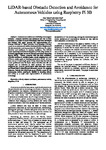LiDAR-based Obstacle Detection and Avoidance for Autonomous Vehicles using Raspberry Pi 3B
| dc.contributor.author | Calcroft, M | |
| dc.contributor.author | Khan, Asiya | |
| dc.date.accessioned | 2022-11-07T11:35:10Z | |
| dc.date.available | 2022-11-07T11:35:10Z | |
| dc.date.issued | 2022-04-20 | |
| dc.identifier.isbn | 978-1-6654-5200-7 | |
| dc.identifier.uri | http://hdl.handle.net/10026.1/19862 | |
| dc.description.abstract |
Autonomous vehicles are redefining the transport industry – obstacle detection and avoidance are key to their operation. A number of sensor technologies have been developed and trialled. This paper presents the implementation of a Hokuyo URG-04LX Light Detection And Ranging (LiDAR) sensor on an autonomous vehicle developed with a Raspberry Pi 3B microcontroller and demonstrates its effectiveness for object detection and avoidance in varying conditions. The LiDAR sensor was integrated with the Raspberry Pi 3B using Python on LUbuntu (lightweight version of Ubuntu) and Robot Operating System (ROS). Various scenarios with low light conditions, reflective surfaces at multiple angles, simple stopping tests and different motion paths at varying speeds were tested. All tests were run at 3.2 and 4mph speed. It was found that the LiDAR sensor performed well for basic object detection but did not respond well to reflective or dark surfaces. We further compared the LiDAR’s performance with ultrasonic sensors and found that it outperformed ultrasonic sensors for stopping distances. Overall, the LiDAR acts as an effective sensor for the autonomous vehicle, showing its viability in detecting objects and acting as a small scale representation of autonomous technology. | |
| dc.format.extent | 24-29 | |
| dc.language.iso | en | |
| dc.publisher | IEEE | |
| dc.title | LiDAR-based Obstacle Detection and Avoidance for Autonomous Vehicles using Raspberry Pi 3B | |
| dc.type | conference | |
| dc.type | Conference Proceeding | |
| plymouth.author-url | https://www.webofscience.com/api/gateway?GWVersion=2&SrcApp=PARTNER_APP&SrcAuth=LinksAMR&KeyUT=WOS:000839154900005&DestLinkType=FullRecord&DestApp=ALL_WOS&UsrCustomerID=11bb513d99f797142bcfeffcc58ea008 | |
| plymouth.date-start | 2022-04-20 | |
| plymouth.date-finish | 2022-04-22 | |
| plymouth.volume | 00 | |
| plymouth.conference-name | 2022 UKACC 13th International Conference on Control (CONTROL) | |
| plymouth.publication-status | Published | |
| plymouth.journal | 2022 UKACC 13th International Conference on Control (CONTROL) | |
| dc.identifier.doi | 10.1109/control55989.2022.9781465 | |
| plymouth.organisational-group | /Plymouth | |
| plymouth.organisational-group | /Plymouth/Faculty of Science and Engineering | |
| plymouth.organisational-group | /Plymouth/Faculty of Science and Engineering/School of Engineering, Computing and Mathematics | |
| plymouth.organisational-group | /Plymouth/REF 2021 Researchers by UoA | |
| plymouth.organisational-group | /Plymouth/REF 2021 Researchers by UoA/UoA12 Engineering | |
| plymouth.organisational-group | /Plymouth/Users by role | |
| plymouth.organisational-group | /Plymouth/Users by role/Academics | |
| dcterms.dateAccepted | 2022-02-17 | |
| dc.rights.embargodate | 2022-11-15 | |
| dc.rights.embargoperiod | Not known | |
| rioxxterms.versionofrecord | 10.1109/control55989.2022.9781465 | |
| rioxxterms.licenseref.uri | http://www.rioxx.net/licenses/all-rights-reserved | |
| rioxxterms.type | Conference Paper/Proceeding/Abstract |


